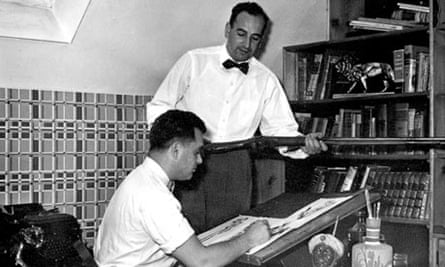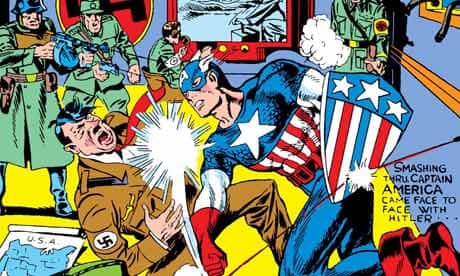Joe Simon, who has died aged 98, was one of the architects of the golden age of US superhero comics. In 1940 he and Jack Kirby created Captain America as the embodiment of the nation's ideals. The ultimate patriot, clad in a tight-fitting, stars-and-stripes costume, the character was a call to arms by Simon, who believed that American participation in the second world war was inevitable.
In the first issue of the comic, the axis powers already had their eyes set firmly on the peace-loving US, and the cover showed Captain America's response: a right hook to Hitler's jaw. Although Captain America sold almost 1m copies per issue, surprisingly he was not Simon's biggest seller. That was a title aimed at female readers, Young Romance.
Born Hymie Simon but known as Joseph, he was the second child of a tailor, Harry Simon, and his wife, Rose. Raised in straitened circumstances in Rochester, New York, Simon attended Benjamin Franklin high school. He went on to work in the art departments of the Rochester Journal-American and the Syracuse Herald; drew editorial and sports cartoons; retouched publicity photos for Paramount; and illustrated magazine stories. He was recommended to Lloyd Jacquet of Funnies Inc, which packaged comics for a variety of publishers. After his first effort (a western) was accepted, he was asked to create a new character for Timely Comics. Simon's costumed hero Fiery Mask made his debut in Timely's Daring Mystery Comics.
While creating the superhero Blue Bolt, Simon met Kirby, and they collaborated on the second issue of the comic. Soon, Simon was hired as an editor by Martin Goodman of Timely and, almost immediately, they had a runaway hit on their hands when the first issue of Captain America was published in December 1940. Simon brought Kirby over to Timely and they enjoyed a long-running partnership. In the early days, Simon would rough out stories on the page which Kirby – with his flair for dynamic action – would then pencil and Simon would ink. This method would alter to fit their deadlines, and assistants were brought in to help with the workload.
Simon parted company with Goodman after a disagreement about money and moved on to the rival National Comics. There, he and Kirby created Manhunter (a big-game hunter turned costumed crime fighter) and the Boy Commandos (an elite, international group of young soldiers who outsold even Captain America).
Simon served with the coastguard in the second world war, first on patrol at Long Beach Island and subsequently with the Public Information Division in Washington, during which time he created comics to attract new recruits. On his return to New York, he and Kirby began working for Harvey Comics, creating Stuntman and Boy Explorers. It was at Harvey that Simon met his wife, Harriet, whom he married in 1946.
A postwar downturn in interest in superheroes led Simon and Kirby to other genres. They transformed Headline Comics, changing its focus from superheroes to gangsters and murderers, and created a companion comic, Justice Traps the Guilty. At Hillman, they worked on a teen romance, My Date, the success of which led to Crestwood Publications offering them a 50% profit share if they created a romance title. The result, Young Romance, topped 1m sales per issue, as did its companion title, Young Love.

To help them cope with demand, Simon and Kirby employed artists including Bill Draut, Mort Meskin and John Prentice. The pair launched Young Brides, Charlie Chan (based on the Earl Derr Biggers character), Black Magic and Boys' Ranch. They set up Mainline Publications in 1953 and covered a range of genres in the titles they launched: Bullseye (western), Foxhole (war), In Love (romance) and Police Trap (crime). Their last major new character, Fighting American (a superpatriotic Captain America for the "reds under the bed" era), appeared in 1954.
Legal battles ended their relationship with Crestwood, and Mainline's distributor went into bankruptcy. Simon and Kirby then sold their titles to Charlton Comics and split. Simon began working for an advertising agency but reunited with Kirby to create Adventures of the Fly and revamp The Shield for Archie Comics.
In 1960 Simon created the satirical magazine Sick as a rival to Mad. He then wrote and drew Brother Power the Geek, about a Pinocchio-style figure wandering through hippy culture in the late 1960s. In 1973, with the public's eyes on Watergate, he launched Prez, in which a teenager is voted president. It was cancelled after four issues. Simon wrote a handful of later comics, including The Sandman, another collaboration with Kirby, in the mid-70s.
Simon's publications included The Comic Book Makers (1990, revised 2003) and My Life in Comics (2011). He was inducted into the Will Eisner Award Hall of Fame in 1999. A long-running battle with Marvel over the copyright of Captain America was settled out of court in 2003. Simon never lost his enthusiasm for the character and keenly supported the film Captain America: The First Avenger (2011).
He is survived by five children and eight grandchildren.
